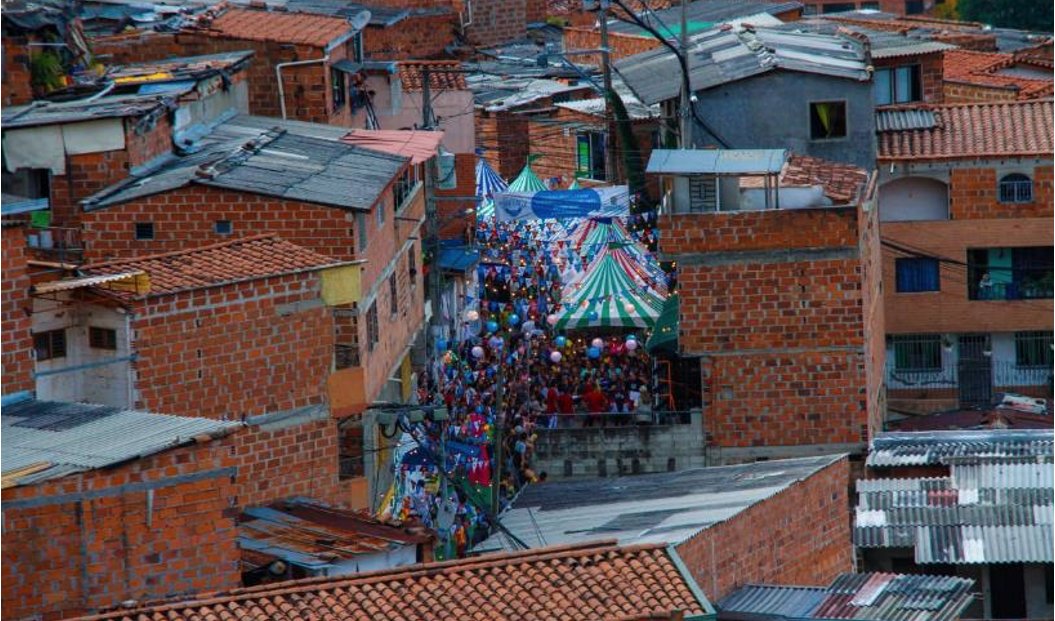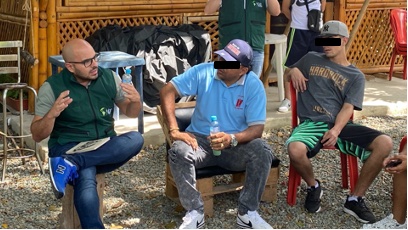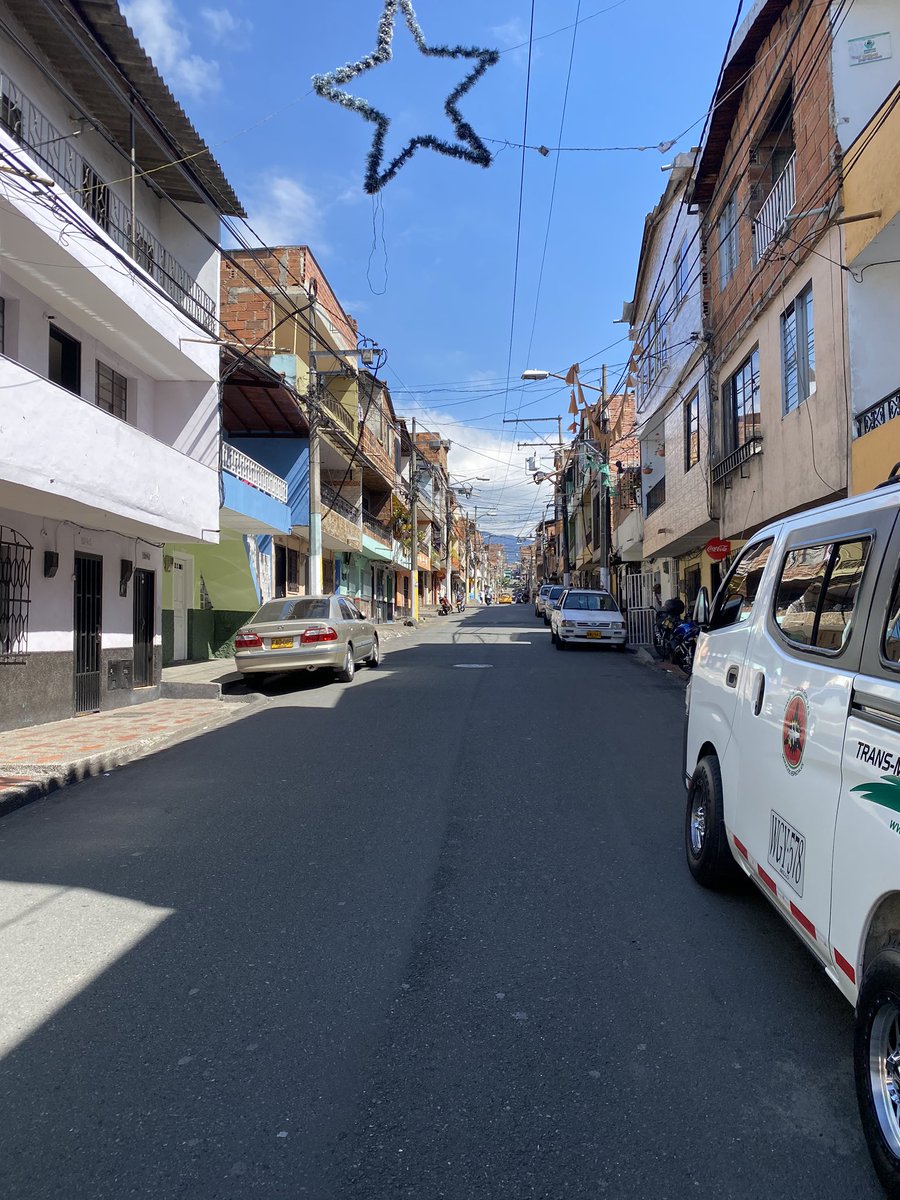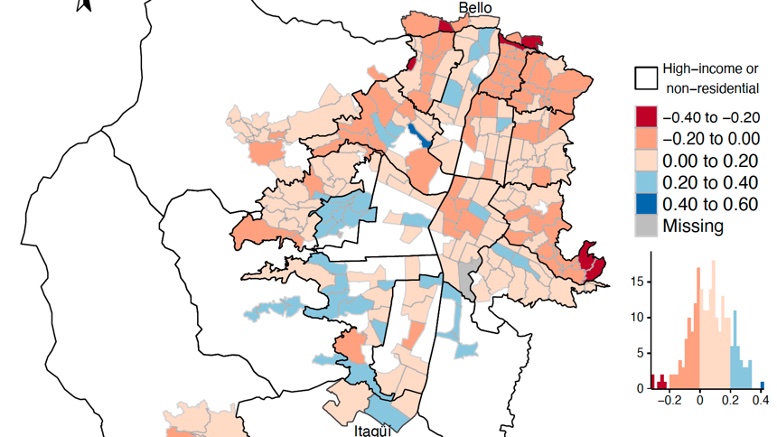
Here's a story of unintended consequences, of academic theories and government policy gone wrong, of how damn hard it is to tackle organized crime, and of insights into what criminal organizations really want and do.
It starts in Medellin.
[Paper: osf.io/preprints/soca…]
It starts in Medellin.
[Paper: osf.io/preprints/soca…]

First thing you need to know: Every low and middle income neighborhood in the city has a neighborhood gang called a combo. We did a census of them. Here's how it looks. Every square inch is claimed by one combo or another. 

This is valuable territory. There's a healthy retail drug market. They make and collect loans. Some even run local monopolies on staples like arepas, eggs, yogurt, and cooking gas in neighborhoods like this. 

Combos also charge local shops for protection. This isn't necessarily an extortion racket. That's because many provide real governance services--resolving disputes, policing, enforcing contracts, all for fees and weekly taxes they call a "vacuna"--literally, a vaccine. 

We know this partly because a team led by me and my coauthors--@BigBigBLessing @gusduncan @SantiagoTobon--spent 4 years interviewing combo members and leaders--about 70 of them from 30 groups. Here's one with extraordinary levels of local rule. 

Behind him was a craft center for training local kids. Behind that is the recycling center they run, and here is the community pool they built with a combination of drug profits and a grant their NGO got from @USAID. [To be fair, USAID had no idea.] It's hard to know this stuff. 

We also know about gang rule because we ran a representative survey of ~5000 citizens. Here's a map of relative rule from the state vs the combo. Redder areas have more combo policing and dispute resolution than state protections services. 

OK, so you might think that combos rule where the state is weak. This is a good guess. And so you might think that, if the state expands its capacity and quality, gangs will get crowded out of protection. That's what we thought too. But we were wrong.
Let's jump to a finding, then work backwards. Here's a city map. The dots are blocks where we surveyed residents. The lines are internal borders called comunas. The city has 16 of them. They introduced the borders in 1987. 

Over the next decades, the city ramped up protection services. The squares are police stations and the triangles are "Justice Houses" that provide dispute resolution, family services, etc. After 1987, these services got reorganized to get delivered within the comuna only. 

So look at any two red dots--these are blocks close to the borders. At the median, a block on one side of the new border is ~0.5km further from their local police & justice services than the other. Cross the border, and your proximity to the state plunges. 

Otherwise, the two blocks don't really differ. They have the same schooling and health services (not delivered at the comuna level), the same distance to business centers and wealth, etc. Only state protection changes discontinuously at the border. 

No surprise, cross the border, get 0.5km closer to the state, and citizens say that state protection goes up--about 20%.
Now the kicker: They also say that combo protection services go up 20%. What the...??
Now the kicker: They also say that combo protection services go up 20%. What the...??

OK, let's roll back to those leader interviews. First thing they told us: protection is a business line. It's a good they sell. State and gang protection are substitutes on the market.
But that won't explain our result. Take any model of duopolistic competition. Or a model of stationary bandits providing public goods for taxes. (We did both.) Almost all say the state will crowd out gang. If a state exogenously increases protection services, the combo's drops.
OK, so second thing they told us: warm glows. “Personally, doing good work feels good," one said, "You can be the worst bandit, but you can also have a good heart of your own.” They like the status and respect. So there are non-material returns.
But the third thing is the most important: Loyalty. "The community shields you according to your behavior," said one, "If you do not have the community in your hands and your back, you have nothing. That is who takes care of you.” They hide you from the cops. They don't rat.
Related: “There is a good relationship with the people,” and therefore, “it is easier to bring order in the sector and so the police do not have to come around.” Providing protection reduces the need for the state to come around. 

What loyalty and reducing state presence does is simple: It enhances drug profits and other illicit rents. Ruling is a business line, but it's one with positive externalities for other business lines.
Now put this in a duopoly or dueling stationary bandit model, and you get a different result. If the returns of ruling (to status, drug profits...) are great enough, and if that depends on the combo's rule *relative* to the state, then increasing state rule can crowd IN gang rule
That helps explain the border result above. It also helps explain why the vacunas are often low. Very few residents described them as high. They'd a couple percent of shop profits. And many shops aren't asked to pay, especially if their loyalty is needed. 

Of course, you might not be totally convinced by the border quasi-experiment. So we also ran a field experiment with the city. As far as we know, this is the first gang-level field experiment ever.
This is La Loma. We stumbled upon a small program here. The city sent civilian liaisons in to govern intensely & well. To help residents solve problems. And to connect them to state protection & social services, for 5 years. We brought this to the Mayor and suggested they scale. 

The city identified 80 gang-heavy neighborhoods of about 500 homes. They hired 40 liaisons and sent them to half these sectors for two years. Their job: to help govern better, identify problems, and connect people to broader city services. Basically, improve rule. 

Two years later, what was the effect on relative state rule?
I've reached the thread limit, so you'll have to follow this new thread here:
I've reached the thread limit, so you'll have to follow this new thread here:
https://twitter.com/cblatts/status/1357687967247175689?s=20
• • •
Missing some Tweet in this thread? You can try to
force a refresh







